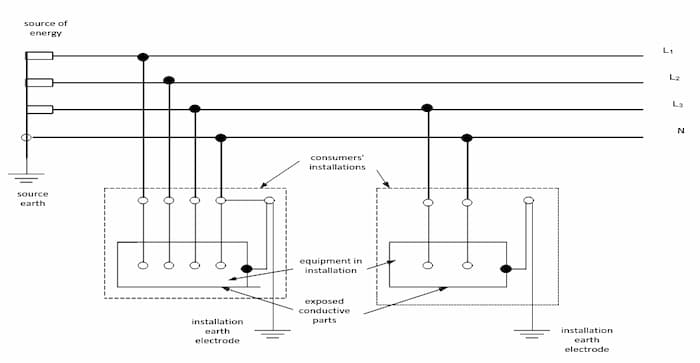Earthing
An effective earthing system avoids having dangerous potentials on the equipment even during electrical faults and also ensures the proper operation of electrical protection equipment during fault condition.
Potential of an installation is measured with respect to earth.
Earthing is done for 2 purposes.
Neutral Earthing
Limiting the voltage of current carrying conductors forming a part of the system.
This is important because the performance of the system in terms of short circuits, stability, protection, etc., is greatly affected by the state of the neutral conductor. When the neutral is properly grounded, voltages of the phases are limited to near phase to ground voltage.
Equipment Earthing
Limiting the potential of non-current carrying metal work associated with equipment, apparatus and appliances in the system.
Refers to grounding of all non-current carrying metal work of equipment. Governed by various regulations such as the IEE regulations. The objectives of this grounding are:
- To ensure effective and rapid operation of the protective gear in the event of earth fault currents. Otherwise, those currents might be undetected, cause fire
- Protect against danger to life through shock due to installation metal work being maintained at a dangerous potential relative to earth
Types of earthing arrangements
In the regulations for electrical installations, the types of earthing systems are identified as follows, depending on the relationship of the source (supply authority network) and of the exposed conductive parts of the installation, to earth.
- TN - earthing of the installation is done to that supplied by the supply authority
- TT - supply authority earth and the installation earth is independent
- IT - supply authority has effectively an isolated neutral and the installation has an independent earth
Above the first letter means:
- T - Short for terra. Refers to one or more points of the source to earth
- I - Short for isolated. Indicates either:
- (i) all live parts are isolated from earth
- (ii) one point of live is connected to earth through high impedance
Above the second letter means:
- T - Denotes a direct connection from exposed parts of consumer installation to earth, independently of any point of the supply authority side
- N - Denotes a direct electrical connection of the exposed conductive parts to the earthed point of the supply authority side (which is usually the neutral point)
TT system
Used in Sri Lanka. Supply is earthed at the source end. All exposed conductive parts of the installation are connected to earth (independent earth electrode) at consumer end.

The normal earthing practice is to provide a circuit protective conductor throughout every installation. A circuit protective conductor connects exposed conductive parts of equipment to the main earthing terminal.